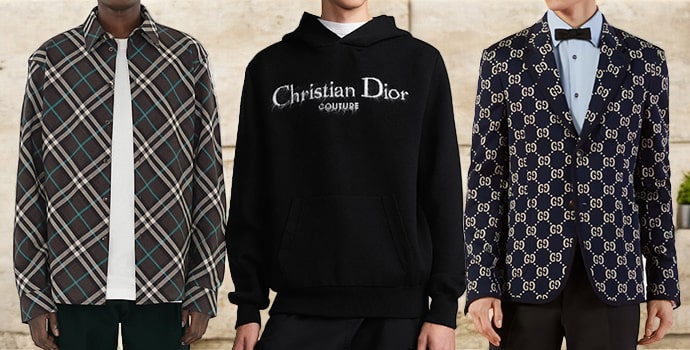Is Branded Clothing Really Better Because of the Fabric?
Is Branded Clothing Really Better Because of the Fabric?
Blog Article
Understanding Garments: The Significance of Textile Selections in Your Closet
The option of textile in garments plays a crucial role in both visual appeals and capability. Various products use varying degrees of convenience, resilience, and breathability, straight affecting the wearer's experience. Comprehending these subtleties can improve one's closet considerably. Yet, many overlook just how these selections can affect not simply personal style, yet additionally sustainability. What material decisions could redefine your wardrobe and align it with both design and duty?
The Function of Fabric in Style and Capability

Usual Textile Types and Their Qualities
When selecting clothes, understanding the features of usual textile types is important for making notified selections. Cotton, a widely-used all-natural fiber, is recognized for its soft qualities, breathability, and flexibility, making it appropriate for sportswear and everyday garments. Linen, one more natural option, boasts excellent moisture-wicking residential properties and a distinct structure, perfect for cozy climates.Wool, commonly favored for its warmth and longevity, differs in fineness; merino woollen is soft versus the skin, while coarser kinds are made use of for outerwear. Artificial textiles like polyester and nylon use resilience and resistance to creases, making them popular for activewear and traveling garments. Lastly, blends, which integrate natural and artificial fibers, can boost capability while keeping convenience. By acknowledging these material characteristics, individuals can choose apparel that aligns with their way of life and aesthetic preferences.
Breathability and Comfort: Choosing the Right Fabrics for Different Climates
Picking the appropriate fabrics for different environments can significantly boost convenience and general wearability. Breathable products are necessary in warm climates, as they permit air blood circulation and moisture evaporation. Fabrics such as cotton, linen, and moisture-wicking synthetics effectively attract sweat far from the body, maintaining the wearer cool and completely dry. Alternatively, in chillier climates, thicker textiles like woollen or fleece offer insulation while maintaining breathability, guaranteeing warmth without overheating.Additionally, the selection of material weight plays a vital function; lightweight fabrics are more effective for summer, whereas heavier options are fit for winter wear. Comprehending the unique residential or commercial properties of each material enables people to dress appropriately for differing weather problems. Ultimately, choosing breathable and comfortable fabrics tailored to particular environments can substantially enhance daily comfort and improve the overall experience of using apparel.
Resilience and Treatment: Exactly How Fabric Impacts Long Life of Your Closet
Picking the appropriate products can greatly impact the durability and treatment requirements of a closet. Fabrics such as cotton and polyester are known for their durability and ease of upkeep, making them ideal for everyday wear. In comparison, fragile products like silk and lace need even more careful handling and specialized cleansing methods, which can increase the moment and effort required for care. Branded Clothing.Durability is also affected by the material's weave and finish; securely woven fabrics have a tendency to withstand wear and tear far better than freely woven alternatives. In addition, artificial blends often provide improved toughness, combining the most effective qualities of several fibers.Understanding the care guidelines for each material is necessary, as inappropriate washing or drying can cause early wear. Inevitably, selecting resilient products can bring about a longer-lasting closet, lowering the regularity of substitutes and contributing to a much more sustainable style selection
The Impact of Material on Fit and Shape

Lasting Textile Selections: Making Eco-Friendly Decisions
The influence of material expands past fit and silhouette to incorporate environmental elements, triggering a growing rate of interest in lasting fabric options. Eco-friendly fabrics, such as natural cotton, hemp, and Tencel, are obtaining grip among consumers that focus find more info on sustainability in their wardrobes. These materials are go to this web-site commonly created with less chemicals and water, minimizing their eco-friendly footprint.Additionally, recycled fabrics, made from post-consumer waste, supply a cutting-edge option to the textile market's air pollution problem. Brands progressively embrace openness in their sourcing techniques, allowing consumers to make informed choices regarding their purchases.Choosing lasting fabrics not just supports honest methods however additionally motivates the apparel industry to embrace more liable production approaches. As awareness of environmental issues increases, individuals are urged to assess the long-term influence of their textile options, cultivating a motion in the direction of a much more sustainable and environmentally conscious technique to fashion.
Elevating Design: Just How Fabric Can Change an Attire
While lots of may focus on color and cut when choosing an attire, the option of material plays a crucial role in boosting style and improving general look. Different products convey unique state of minds and messages; for instance, silk exudes deluxe and class, while jeans supplies an informal, loosened up vibe. The texture and drape of a material can drastically modify the shape, with organized textiles supplying a polished look and softer ones creating a more fluid, kicked back aesthetic.Moreover, the weight of the fabric affects wearability across periods. Lightweight textiles like linen and cotton are excellent for summer season, while larger materials such as woollen and velour offer heat and style in colder months. Understanding fabric residential or commercial properties, such as breathability and stretch, also equips people to make informed options that boost convenience without compromising style. Ultimately, the ideal material can transform learn this here now an outfit from ordinary to extraordinary, making it an essential factor to consider in any type of wardrobe.
Frequently Asked Inquiries
Exactly how Do I Determine the Textile Web Content of My Clothing?
To recognize textile material, one can take a look at treatment tags, conduct melt examinations for fiber recognition, or get in touch with textile examples. These approaches assist distinguish materials, making certain educated selections for garments care and maintenance in day-to-day wear.
Can Textile Selection Affect My State Of Mind or Confidence?
Fabric selection can greatly influence an individual's state of mind and confidence. Branded Clothing. Certain materials may evoke feelings of comfort or style, while others can really feel restrictive or uncomplimentary, eventually influencing self-perception and psychological wellness throughout the day
What Fabrics Are Finest for Sensitive Skin?
For people with delicate skin, natural materials like cotton, linen, and bamboo are typically recommended. These products are breathable, hypoallergenic, and much less likely to cause irritation, making them suitable selections for comfort and skin health and wellness.
Exactly how Do I Properly Laundry and Treatment for Various Fabrics?
To effectively care and wash for various materials, one must think about each product's particular requirements, including temperature settings, detergents, and drying approaches, ensuring durability and keeping the fabric's original qualities for optimal use.
Are There Specific Fabrics for Athletic or Efficiency Wear?
Athletic or efficiency wear usually uses textiles such as nylon, spandex, and polyester. These materials are designed for moisture-wicking, breathability, and flexibility, improving movement and convenience during exercises while offering durability and support. Alternatively, in chillier climates, thicker textiles like wool or fleece give insulation while maintaining breathability, making sure heat without overheating.Additionally, the choice of fabric weight plays an important duty; light-weight textiles are better for summer season, whereas larger alternatives are fit for wintertime wear. In contrast, delicate materials like silk and shoelace require more careful handling and specialized cleansing techniques, which can enhance the time and effort required for care.Durability is additionally influenced by the textile's weave and coating; securely woven fabrics have a tendency to withstand wear and tear better than freely woven alternatives. In comparison, rigid textiles can restrict movement yet offer a timeless, refined look.Moreover, the thickness and appearance of the material can influence the aesthetic assumption of body shape. The influence of material expands past fit and silhouette to incorporate environmental elements, motivating an expanding passion in lasting material choices. The appearance and drape of a material can dramatically change the shape, with structured materials offering a polished look and softer ones creating a more fluid, unwinded aesthetic.Moreover, the weight of the material influences wearability throughout seasons.
Report this page